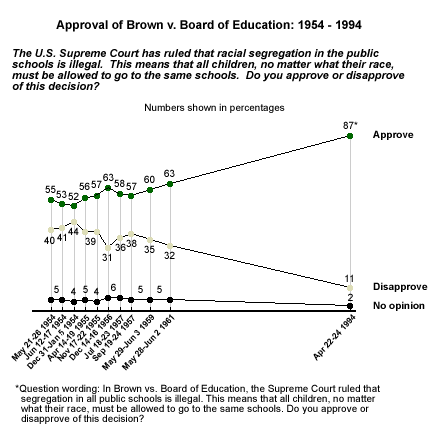Forty-five years ago, Elizabeth Eckford and eight other black students (known as the "Little Rock Nine") were the first black students to attend all-white Little Rock (Ark.) Central High. This article, the second installment in a two-part series, picks up the story after the nine started school -- after a 21-day standoff with segregation supporters, including the governor of Arkansas.
The Little Rock Nine finally made it into school on Sept. 25, 1957, but their ordeal was far from over. White students verbally and physically attacked them on a regular basis, and teachers and administrators seemed to look the other way. Moreover, the black students were not allowed to retaliate, no matter what happened.
"If a teacher didn't see it, they didn't have to respond to it," Eckford says. "I learned later, secondhand, that the principal had even said he wished the students would run us off the next year."
Eckford didn't tell her parents much about what it was like in school. "I knew I would not have been allowed to stay," she says. "My mother … was never fully aware of what our school days were like. She knew that there was unpleasantness and that we encountered a lot of prejudice. She didn't know the extent of the physical attacks and the regularity of it … Those things weren't printed in the paper."
The School Year That Wasn't
The 1957-1958 school year ended more peacefully than it began -- one of the nine, Ernest Green, graduated from Central High without incident. However, those who opposed desegregation didn't want to make these graduations a habit.
In June 1958, Federal District Judge Harry J. Lemley granted the Little Rock school board a 30-month delay in integrating schools, stating that while black students have a constitutional right to attend white schools, the "time has not come for them to enjoy that right."
Gallup asked Americans in July 1958 whether they approved or disapproved of Lemley's ruling -- 47% approved and 44% disapproved. Lemley's decision was overturned on appeal and sent to the Supreme Court, which ruled that Little Rock must continue its desegregation.
Arkansas Gov. Orval Faubus disrupted the desegregation efforts by closing all high schools in Little Rock for a year. Eckford would never go back to Central High, although two of the nine did return to Central for their senior year when the schools reopened in 1959. All grades in Little Rock's public schools were finally integrated in 1972.
Brown v. Board of Education
In looking at public opinion surrounding the Little Rock case, it's helpful to understand how the public felt about the landmark federal school desegregation order that was being tested in Little Rock. On May 17, 1954, the Supreme Court issued its first ruling on Brown v. Board of Education, which declared racial segregation in public schools illegal. Gallup began polling Americans on their opinions of the court's ruling days after it was handed down, and continued to do so somewhat regularly until 1961.
Gallup asked Americans, "The U.S. Supreme Court has ruled that racial segregation in the public schools is illegal. This means that all children, no matter what their race, must be allowed to go to the same schools. Do you approve or disapprove of this decision?"

Multiple measurements gathered between May 21-26, 1954, and Sept. 19-24, 1957 (during the desegregation of Little Rock Central High), showed a majority of Americans approved of the ruling.
That surprises Eckford. "I remember the open talk of trying to impeach Earl Warren and the Warren Court," she says, "It shocks me. That was not what I experienced. I experienced that most people didn't question the customs and laws of segregation. Most blacks did not challenge it, and whites probably accepted it as a matter of course -- [as] their right."
The regional patterns among Americans who approved and disapproved of the court's decision may offer a partial explanation for Eckford's surprise. From 1954 through September 1957, at least a majority of Americans living in the East, Midwest, and West (typically greater than 60%) approved of the court's decision. In the South, the numbers were dramatically different: about 7 in 10 Southerners disapproved during this time.
In response to a special survey on the Mood of the South, conducted in late 1957, 83% of Southerners said they disapproved of the decision, 15% approved, and 2% had no opinion. In that same survey, Southern blacks were asked whether they approved or disapproved of the Supreme Court's decision: 69% approved, 13% disapproved, and 18% had no opinion.
In 1956, roughly 6 in 10 Americans approved of the court's decision, with percentages falling to the high-50s in subsequent readings. But by 1959, the percentage approving was back above 60% and rose to 63% percent in 1961, the last time that the question was asked for 33 years.
By 1994, the 40th anniversary of Brown v. Board of Education, the social climate had changed considerably: 87% of Americans approved of the Supreme Court's ruling and 11% disapproved. That change made it clear that though progress takes time, the sacrifices of Eckford and others like her had a clear impact on the national consciousness.